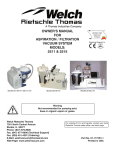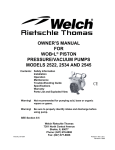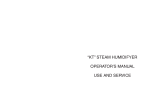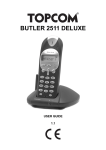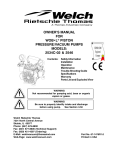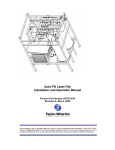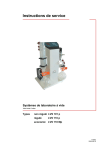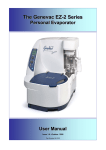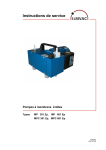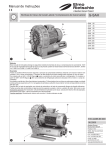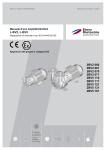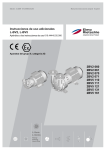Download Welch® Owners Manual FOR PRESSURE/VACUUM PUMP MODEL
Transcript
Welch® Owners Manual FOR PRESSURE/VACUUM PUMP MODEL 2511 Contents: Safety Information Installation Operation Maintenance Specifications Warranty Read and understand the following information and instructions included with your Welch Pressure/Vacuum Pumps before using. This information is for your safety and to prevent damage to the pump. I. SAFETY INFORMATION I-1. I-1a. CAUTION: TO PREVENT INJURY… Never operate this product if it has a damaged cord or plug. If it is not working properly, has been dropped, damaged or has fallen into water, please return the product to a service center for examination and repair. Keep the cord away from heated surfaces. Never block any air openings. The air openings are for ventilation of the motor inside the plastic housing. Keep all air openings free of lint, dirt and other foreign objects. Never drop any object into any openings. This pump has a single use (fuse) type of overload protector. If the motor should overheat, the protector will shut the unit off. If this should occur, unplug the pump and contact the service center. Do not use any tools or attachments without first determining maximum air pressure for that tool or attachment. Be sure to properly identify vacuum and pressure ports before using pump. See labels on pump next to hose fittings. I-1b. I-1c. I-1d. I-1e. I-1f. I-1g. I-2. I-2a. I-2b. I-2c. WARNING: TO REDUCE RISK OF ELECTROCUTION… Do not use this product in or near an area where it can fall or be pulled into water or other liquids. Do not reach for this product if it has fallen into liquid. Unplug immediately. Use indoors only. I-3. I-3a. 1-3b. I-3c. I-3d. DANGER: TO REDUCE RISK OF EXPLOSION OR FIRE… Do not use this pump in or near explosive atmospheres or where aerosol (spray) products are being used. Do not use this station for organic, basic or acidic vapors. Do not use this station in or near an area where flammable or explosive liquids or vapors may exist. Do not use this product near flames. I-4. I-4a. SERVICING OF A DOUBLE-INSULATED PRODUCT In a double-insulated product, two systems of insulation are provided instead of grounding. No grounding means is provided on a double-insulated product, nor should a means for grounding be added to the product. Servicing of a double-insulated product requires extreme care and knowledge of the system and should be done only by qualified service personnel. Replacement parts for a double-insulated product must be identical to those parts in the product. CLASSIFICATION AND SYMBOL GLOSSARY Double Insulated Printed in U.S.A. On (power) 1 Off (power) Part No. 642317 Rev. D 06/09 II. INSTALLATION II-1. INTRODUCTION This manual has been compiled not only for the care and maintenance of the Welch Dry Pressure/Vacuum pump now in your possession, but as a helpful reference and guide to prevent many problems which can occur if used improperly. II-2. UNPACKING Carefully remove the Pressure/Vacuum pump from the shipping carton. Preserve all paperwork for future reference. If damage has occurred from shipment, a claim must be filed with the carrier immediately; preserve the shipping carton for inspection by the carrier. If you are required to communicate with your dealer or Welch Vacuum be to include your order numbers for quick identification. Do not return the pump to the factory without first calling for a returned goods number. II-3. PUMP MOUNTING Rubber bumper feet are attached to the pump. Rubber bumper feet are excellent for applications involving a semi-flexible surface such as a bench top; they help to isolate noise and eliminate creeping. The Pressure/Vacuum pump should be mounted in a horizontal plane. II-4. PUMP LOCATION The pressure/vacuum pump should be located preferably in a clean, dry and well-ventilated area. Please be sure not to block the ventilation ports located on the plastic housing. The pump should be placed where the surrounding temperature remains between 10°C and 40°C (50°F and 104°F). Always check to insure the location chosen is protected from direct or indirect moisture contact. II-5. PRESSURE AND VACUUM CONNECTIONS On the side of the plastic house are located two hose barb fittings. The top hose barb fitting supplies pressure. The bottom hose barb fitting supplies vacuum. Be sure to call Welch technical service prior to start-up at (847) 676-8800 if you have any questions. II-6. ELECTRICAL POWER II-6a. POWER SOURCE REVIEW Review the power source to be sure they agree in voltage, phase and frequency. Serious damage may occur to the motor if it is connected to an improper voltage. II-6b. POLARIZED PLUG This product has a polarized plug (one blade is wider than the other on 115VAC model). This plug will fit in a polarized outlet only one way. If the plug does not fit fully in the outlet, reverse the plug. If it still does not fit, contact a qualified electrician to install the proper outlet. Do not change the plug in any way. II-6c. CORD When unit is not in use, wrap cord securely and store unit in a dry place. Do no abuse cord or plug. II-6d OVERLOAD PROTECTION. This pump has a single use (fuse) type of overload protector. If the motor should overheat, the protector will shut the unit off. If this should occur, unplug the pump and contact the service center. II-7. VACUUM CONNECTIONS All pressure/vacuum pumps come with intake and discharge hose barbs which accept ¼” ID rubber pressure/vacuum hose. Hose clamps should be used to hold the hose in place. For best results, we recommend the length of the tubing between the pump and the chamber be kept as short as possible. II-8. VACUUM AND PRESSURE GAUGES A common vacuum gauge used for measuring in mmHg or inHg is the dial vacuum gauge. The dial vacuum gauge gives negative pressure – that is pressure below atmospheric. The reference point for the vacuum gauge is atmospheric pressure. Please keep in mind that atmospheric pressure tends to vary from day to day. As a result of this variability the dial vacuum gauge will indicate different maximum vacuum readings from day to day. A common pressure gauge is the dial pressure gauge gives pressure above atmospheric. The reference point for the pressure gauge is atmospheric pressure. 2 III. OPERATION III-1. STARTING PROCEDURES III-1a. STARTING THE PRESSURE/VACUUM PUMP. Before attaching the pump to a system we recommend you familiarize yourself with the function and action of the Pressure/Vacuum pump which you have acquired. Review the power requirements as described in Section II-6. We recommend running the pump for a few minutes to warm it up before use. The warm-up improves the pump ability to handle humid air. III-1b. CLEANLINESS Take every precaution to prevent foreign particulate from entering the pump. Particulates will damage the pump’s performance. If you find that particulates will come off the process during evacuation, a particulate trap in the foreline will work. Placing glass wool in a glass or plastic tube may make a simple, inexpensive trap. Screens must be inserted to hold the glass wool in place. III-2. LEAK DETECTION The importance of eliminating all leaks in a vacuum system is obvious. The pump must remove this added volume of leaked gas to maintain the desired vacuum. Leaks for these pumps can be located by slightly pressuring the system and painting the suspected area with a thick soap solution. Escaping air will produce soap bubbles. III-3. OPERATING PRESSURE RANGE The pressure/vacuum pump is designed to be run from slightly below atmospheric to their maximum vacuum level on the vacuum side. The pumps also may be run from atmospheric to 10 PSIG continuously, to 33 PSIG intermittent. Consult the Specification Table in the back of this manual for the ratings for your specific model. III-4. SHUTDOWN PROCEDURES After use, we recommend the pump be run for about 2 minutes disconnected from the vacuum process. The air pumped through the mechanism will purge out water vapor or droplets of water condensate that may have formed on the inside of the pump. This purge of the pump mechanism helps extend the pumps service life. IV. MAINTENANCE Welch dry pressure/vacuum unit is oil-free. The pump employs a PTFE piston sleeve and cylinder. No maintenance is necessary for the bearings. All bearings are sealed and permanently lubricated. Lubrication should not be attempted. The units are built for continuos and intermittent duty operation with the quietness and durability of a diaphragm, but with piston performance. The Compressor/Pump has a service free lifetime of 2,000 to 3,000 hours. The Compressor/Pump in the plastic housing is not field serviceable. V. TROUBLESHOOTING V-1. VACUUM PROBLEMS Leakage, contamination and unusual outgassing are the general causes of problems associated with poor vacuum. To operate at maximum efficiency a system must be thoroughly clean. If the system is completely clean and free from leaks, and unwarranted vacuum problems still exist, the pump should be checked. A simple criterion for the condition of the pump is the determination of its maximum vacuum capability. This can be accomplished by blocking of the intake and reading the vacuum level on the dial gauge. V-2. PRESSURE PROBLEMS Leakage and contamination are the general causes of problems associated with poor pressure. To operate at maximum efficiency a system must be thoroughly clean. If the system is completely clean and free from leaks, and unwarranted pressure problems still exist, the pump/compressor should be checked by a service technician. 3 VI. SPECIFICATIONS Welch Cat. No. Free Air Displacement, CFM (L/min) Max. Continuous Pressure PSIG (Pascal) Max. Intermittent Pressure PSIG (Pascal) Max. Vacuum, InHg (mmHg) Tubing Needed, I.D. in. Weight, pounds (kg) 2511B-01 2511C-02 2511C-05 2511C-06 0.39 (11) 0.32 (9.2) 0.32 (9.2) 0.32 (9.2) 10 (104) 10 (104) 10 (104) 10 (104) 33 (3.3 x 104) 33 (3.3 x 104) 33 (3.3 x 104) 33 (3.3 x 104) 21.3 (219) 21.3 (219) 21.3 (219) 21.3 (219) 1/4 1/4 1/4 1/4 5 (2.3) 5 (2.3) 5 (2.3) 5 (2.3) 100V, 50/60Hz, 1Ph, 115V, 60Hz, 1Ph, 230V, 50Hz, 1Ph, wired with North wired to accept IEC wired with NEMA 1-15 plug American 115V plug UK & Schuko cord set *Note: 1. 60 Hz model comes with CUL listing. *Note: 2. 50 Hz model provided with CE mark. *Note: 3. 100V., 50/60 Hz model does not have CUL listing or CE mark. Electrical Requirements 230V, 50Hz, 1Ph, wired with UK plug WARRANTY This Welch Vacuum product is warranted to be free from defects in material and workmanship. This liability of Welch Vacuum, Thomas Industries, Inc. under this warranty is limited to servicing adjusting, repairing, or replacing any unit or component part which in the judgement of Welch Vacuum, Thomas Industries, Inc. has not been misused, abused, or altered in any way or damaged by ingestion of foreign material causing impaired performance or rendering it inoperative. Foreign material includes solids, corrosive gases, and recondensed water or solvent vapor. No other warranties are expressed or implied. The method of executing this warranty; servicing, adjusting, repairing, or replacing, shall be at the discretion of Welch Vacuum, Thomas Industries, Inc. Vacuum pumps that have been operating within a vacuum system, or other system, for any period, however short, will be repaired under this warranty rather than replaced. The warranty is effective for one year from the date of original purchase when: 1. The warranty card has been completed and returned. 2. The product is returned to the factory or other designated service centers, freight prepaid. 3. The product in our judgement is defective through no action or fault of the user. If the product has become defective through misuse, abuse, alteration, or ingestion of foreign material, repairs will be billed regardless of the age of the product. In the event, an estimate of the repair costs will be submitted and authorization of these charges will be required before the product is repaired and returned. Welch-Ilmvac 5621 W. Howard Street Niles, IL 60714 Phone: (847) 676-8800 (Technical Support) Fax: (847) 677-8606 E-Mail: [email protected] Web-Page: www.welchvacuum.com This document contains confidential and trade secret information which is the property of Welch Vacuum Technology and receipt or possession does not convey any rights to loan, sell, or otherwise disclose said information, reproduction or use of said information for any purpose other than that in connection with said information was supplied may not be made without express written permission of Welch. This document is to be returned to Welch upon request and in all events upon completion of the purpose for which it is loaned. Copyright© 2008 Gardner Denver Thomas, Inc. Welch Vacuum Technology Welch is a registered trademark of Gardner Denver Thomas, Inc.




